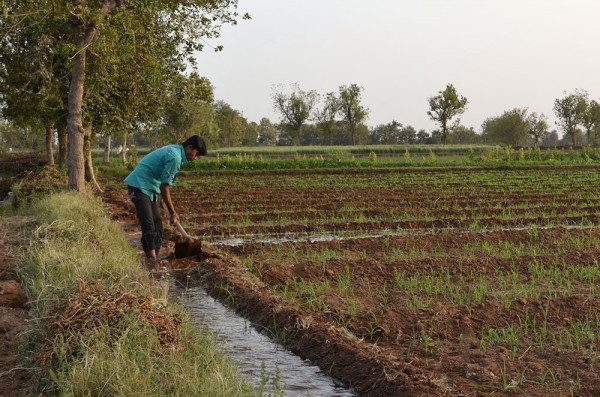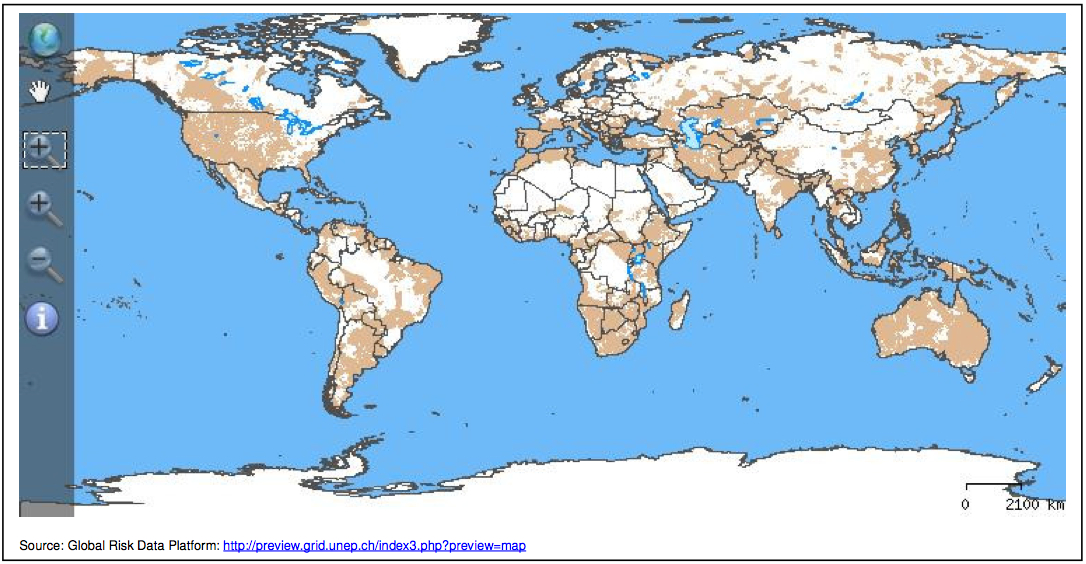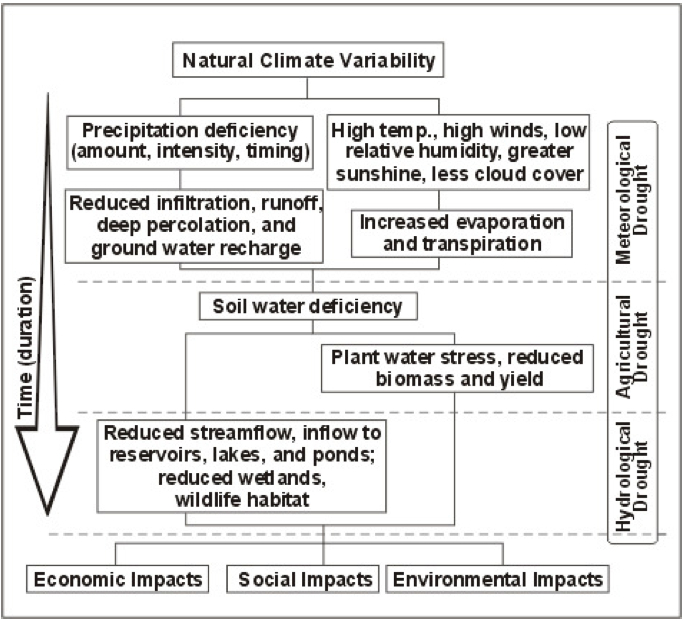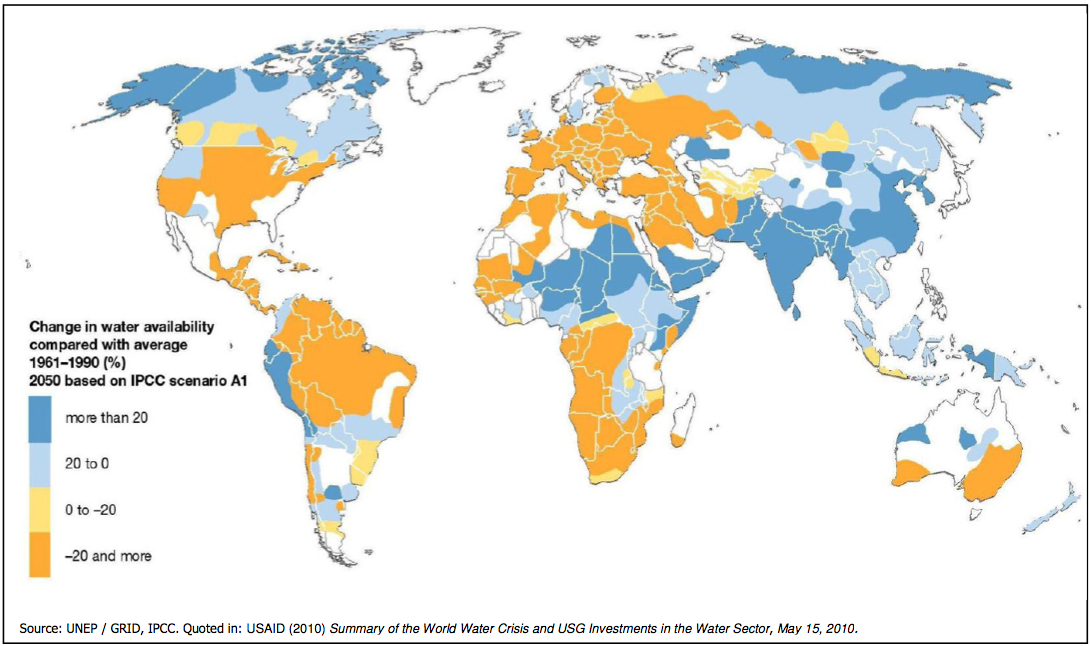Difference between revisions of "Impact of drought on WASH systems"
(→Definitions of drought) |
|||
| Line 54: | Line 54: | ||
Regions, experiencing less water moisture than normal, cover quite a wide area. The world map to the right (with blue background) from the [[File:DroughtMap.jpg|Global Risk Data Platform]] shows the regions with droughts recorded between 1979 and 2008, where drought events are identified as three consecutive months with less than 50% of precipitation as compared with the average. | Regions, experiencing less water moisture than normal, cover quite a wide area. The world map to the right (with blue background) from the [[File:DroughtMap.jpg|Global Risk Data Platform]] shows the regions with droughts recorded between 1979 and 2008, where drought events are identified as three consecutive months with less than 50% of precipitation as compared with the average. | ||
| + | |||
| + | '''More information about how to manage drought and make WASH systems more resilient:''' [[Resilient WASH systems in drought-prone areas]] | ||
{|border="1" cellpadding="5" | {|border="1" cellpadding="5" | ||
| Line 61: | Line 63: | ||
|[[Image:water scarcity map.jpg|thumb|center|300px|Areas in orange lack sufficient water resources to meet basic needs, while purple has water available but lacks the financial and/or technical resources to access the water. Source: USAID, 2010.]] | |[[Image:water scarcity map.jpg|thumb|center|300px|Areas in orange lack sufficient water resources to meet basic needs, while purple has water available but lacks the financial and/or technical resources to access the water. Source: USAID, 2010.]] | ||
|} | |} | ||
| + | |||
==Drought links== | ==Drought links== | ||
Revision as of 03:19, 5 June 2012

Photo: REUTERS. Health of East Africa blog.
It is difficult to predict how and where climate change will have the greatest effects. Every region in the world will not have reduced overall water availability – some areas will have more annual rainfall, while other areas will receive less. Even so, changes in rainfall patterns will increase, with more intense rainfall over shorter periods of time or no rainfall at all for longer periods, including more extreme events such as floods or droughts.
Water availability plays a critical role in people’s ability to handle a drought – especially during drought emergencies.
For example:
- After the 1992-3 drought in Southern Africa, people became aware that drought was definitely linked with management & conservation of surface and ground water sources – questions were asked how to make water supply systems more resistant to drought periods.
- Access to water was the main concern during the drought of 2000 in Afghanistan, even above food supply.
Contents
Drought affects more than just water availability - being prepared
Water supply, however, is only one part of reducing vulnerability. People’s ability to adapt to drought depends on specific livelihood characteristics, in addition, the poor and landless are not automatically the most vulnerable. Increasing the resilience of non-WASH sectors too, such as access to markets, access to finance, levels of infrastructure and employment options must also be engaged.
Both resilience and vulnerability involve a person's capacity to anticipate / cope with / resist / recover from a hazard, and both are determined by physical, environmental, social, economic, political, cultural and institutional factors:
- Vulnerability = potential to suffer harm or loss
- Resilience = potential to cope with harm or loss
- Increased resilience = reduced vulnerability

Photo: Jeremy Hinsdale.
For example, in accessing groundwater and rainwater sources during a drought, more efficient capture and storage of rainwater and groundwater is focused on, rather than expanding the use of groundwater itself. Introducing new techniques to an area is also important. Many rainwater harvesting techniques (e.g. floodwater harvesting and storage) are not only uncommon, but unknown and not used at all. Therefore, understanding what technology works best for a region must include biophysical preconditions, socio-economic conditions, market issues, land tenure issues, and human capacity.
Collecting rainwater more efficiently includes both “blue flow” (water that recharges aquifers, lakes and rivers) as well as “green flow” (water that supports plant/crop production). It is the efficient use of “green flow” that has huge consequences for food security since an estimated 60% of the world’s staple food production relies on this water (and in Sub-Saharan Africa it is almost 100%).
Uncertainty with climate change is a big factor in accurately planning and preparing for WASH resilience. But planning only on changes in rainfall would be too simplistic, as water availability is not solely affected by climate change – population growth and changing water demand also contribute. Supply-side strategies (water volumes and availabilities) therefore need to be planned together with demand-side strategies (population growth, projected increases in demand). Lastly, greater rainfall intensity events may require some structures to be reduced (e.g. embankments, bunds) rather than increased.
Definitions of drought
- Drought is defined as a diversion (may be temporary) from the average or expected rainfall pattern in an area.
- The parameters to officially declare a drought period may vary. For example, drought was considered to have occurred when rainfall during the monsoon season in Asia was less than 80% of the long-term average.
- Drought also affects humid areas. For example, the average annual rainfall in Orissa, India is 1,300mm but it experiences droughts; in Kitui District, Kenya, drought is well documented but annual rainfall is 1,000mm.
- Drought periods can vary from seasons or years to much shorter periods, as is the case with agriculture. For instance, short dry spells in Africa, lasting 2-4 weeks, occur almost every rainy season, negatively affecting crop growth and potential crop productivity. This means that poor rainfall distribution over time is a more common cause of crop failure than low cumulative annual rainfall.
Four approaches to drought
Research by Wilhite and Glantz (1985) of the National Center for Atmospheric Research, in the early 1980s uncovered more than 150 published definitions of drought, reflecting differences in regions, needs, and disciplinary approaches. They categorized the definitions in terms of four basic approaches to measuring drought (see diagram on right):
a. Meteorological: a change in rainfall averages over a period of time. Usually region-specific and the first indicators of drought.
b. Hydrological: a lack of surface and subsurface water supplies, measured as streamflow or lake, reservoir, and groundwater levels. The time lag between lack of rain and less water in streams, rivers, lakes, and reservoirs, means hydrological measurements are not the earliest indicators of drought.
c. Agricultural: when there is not enough soil moisture to meet the needs of a particular crop at a particular time. Agricultural drought happens after meteorological drought but before hydrological drought. Agriculture is usually the first economic sector to be affected by drought.
d. Socioeconomic: when the physical water shortage starts to affect people, individually and collectively. Or, when the supply and demand of an economic good are affected.
Drought and ASALs
Drought also adds stress to arid and semi-arid lands (ASALs), where dry conditions already exist, due to:
- Annual evapotranspiration (PET) rates that are usually more than twice the annual rainfall. These occur due to a mix of high temperatures, greater amounts of sunshine, less cloud cover, high winds and low relative humidity.
- Greatly varied rainfall over geography and time – timing and location of rainfall events is never certain.
- High run-off volume (rather than infiltration). Very common in ASALs.
The case of groundwater in Balochistan demonstrates this – groundwater use has greatly increased due to the expansion in agriculture, rapid population and industrial growth in the last 20 years, resulting in the drying up of water sources like dug wells and springs. This situation was then made worse by the drought between 1998-2002.
Regions, experiencing less water moisture than normal, cover quite a wide area. The world map to the right (with blue background) from the  shows the regions with droughts recorded between 1979 and 2008, where drought events are identified as three consecutive months with less than 50% of precipitation as compared with the average.
shows the regions with droughts recorded between 1979 and 2008, where drought events are identified as three consecutive months with less than 50% of precipitation as compared with the average.
More information about how to manage drought and make WASH systems more resilient: Resilient WASH systems in drought-prone areas
 Water stress in relation to population. Figures are in m3 of water per person per year for 2008. Source: FAO Aquastat database. |
Drought links
Drought, DCM, climate change, pastoralism, IWRM, DRR, participatory approaches
(1) Discusses potential impact of climate change in ASALs and on (2) WASH service delivery.
- Arab Water Council (2009). Vulnerability of arid and semi-arid regions to climate change – Impacts and adaptive strategies. Perspectives on water and climate change adaptation. IRC, The Hague, The Netherlands.
- Batchelor, C.; Schouten, T.; Smits, S.; Moriarty, P.; Butterworth, J. (2009) 14. Climate change and WASH services delivery – Is improved WASH governance the key to effective mitigation and adaptation? Perspectives on water and climate change adaptation. IRC, The Hague, The Netherlands.
Managed Aquifer Recharge (MAR), rain-fed irrigation
Manual on soil & water conservation measures (e.g. bunds).
- Critchley, W.; Siegert, K.; Chapman, C. Finkel, M. (1991) Water Harvesting, A Manual for the Design and Construction of Water Harvesting Schemes for Plant Production. FAO publication AGL/MSC/17/91.
Controlled flooding / spate irrigation / drip irrigation
(1 and 2) Technical guidelines for spate irrigation structures, (2) summarizes 10 years of experience that suggest spate irrigation improvements, and (3) summarizes problems & recommendations from various countries.
- European Union (2008) Design manual volume 1: Technical design criteria. The European Union’s Food Security Programme for Yemen Technical Assistance to the Tihama Development Authority.
- Ratsey, J. (2008). Design manual volume 2: guidelines for wadi diversion and protection works. The European Union’s Food Security Programme for Yemen Technical Assistance to the Tihama Development Authority.
- Steenbergen, F. van; Lawrence, P.; Mehari Haile, A.; Salman, M.; Faurès, J.-M. (2010) Guidelines on spate irrigation. FAO irrigation and drainage paper 65. FAO, Rome, Italy.
- Summary report. Proceedings of the Subregional Expert Consultation on Wadi Development for Agriculture in the Yemen. 1987.
Open reservoirs
(1) Explains risks of cyanobacterial blooms in open reservoirs; (2) overview of effect of fertilizers, pesticides etc on water quality; (3) how to measure seepage rates in reservoirs; (4) how to assess hydrological impact of numerous reservoirs; (5) looks at evaporation rates in reservoirs vs land-based tests.
- Cecchi, P. ; Berger, C.; Couté, A.; Gugger, M.; Zongo, F. (2009) Cyanobacteria, cyanotoxins and potential health hazards in small tropical reservoirs. Small reservoirs toolkit.
- Cecchi, P. ; Leboulanger, C.; Bouvy, M.; Pagano, M.; Nemy, V. (2009) Agricultural intensification and ecological threats around small reservoirs. Small reservoirs toolkit.
- Dekker, T.; Rodrigues, L. N.; Olsthoorn, T.; Giesen, N. van de (2009) Deep Seepage Assessment in Small Reservoirs. Small reservoirs toolkit.
- Giesen, N. van de.; Liebe, J. (2009) Hydrological Impact Assessment of Ensembles of Small Reservoirs. Small reservoirs toolkit.
- Liebe, J.; Giesen, N. van de. ; Steenhuis, T. (2009) Evaporation Losses from Small Reservoirs. Small reservoirs toolkit.
Groundwater, wells, infiltration galleries, boreholes
(1) Code of practice for effective borehole drilling and (2) how to deepen existing boreholes.
- Danert, K.; Armstrong, T.; Adekile, D.; Duffau, B.; Ouedraogo, I.; Kwei, C. (2010) Code of Practice for Cost Effective Boreholes. RWSN, St. Gallen, Switzerland.
- Roscoe Moss Company (1990) Handbook of ground water development. John Wiley & Sons, USA.
Acknowledgements
- CARE Nederland, Desk Study Resilient WASH systems in drought prone areas. October 2010.



